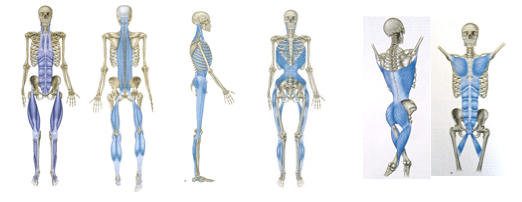
The education provided by Tom Myers’ Anatomy Trains is globally regarded as containing one of the most comprehensive and groundbreaking collections of data for understanding how muscles and fascia work together in the body. I recently had the privilege to attend a weekend seminar organized by Anatomy Trains where practitioners from around the world gathered to learn about the latest research as it relates to pliability, muscles, fascia, and movement.
Based on my experience with clients, education and even intuition, I already had a good idea of what was happening in the body. There are some new scientific findings that I learned in the Anatomy Trains seminar that finally explain some of my intuitive conclusions from working on clients and I’m excited to share this information.
The role of collagen in our muscles
Pain and stiffness in the body result from a build-up of collagen in the tissue. Before I went to the Anatomy Trains seminar, I knew that collagen was being deposited into a muscle, but the question that I had is why? I speculated that it may have been due to a repair mechanism in the body. In other words, when we use a muscle, whether by lifting weights, running or sitting at a desk, we are tearing down that muscle and then the repair process included the production of collagen. I was wondering if it was possible that collagen was being put in almost as patchwork. It turns out that’s not entirely correct.
What’s actually happening is that our body is always trying to be more efficient in anything that it does. There is an existing lattice structure of collagen around individual muscle fibers. These structures are organized in a 50 to 60-degree angle relative to each individual muscle fiber. That orientation is really important because it allows muscle tissue to contract and recoil very effectively and efficiently. So as soon as we start to do something over and over again, we are using very specific muscle fibers in a very specific sequence of contractions. Doing so over and over again tells the body that it needs to become very efficient and effective with this movement.
So what the body does is lay down collagen by following this specific sequence of events and those specific muscle fibers, to enhance the contraction. Essentially, the double lattice is getting thicker at that specific location to enhance movement.
Collagen build-up and athletic performance
Let’s say that the performance of a muscle can be represented by a bell curve. So when we start to do something repetitively, our body recognizes that it needs to make this movement more effective. As a result, collagen is deposited in the muscles in a pattern that is optimal for making that specific movement very efficient, sequential and refined. This creates what people refer to as muscle memory. Eventually, the performance of this movement begins to increase (a climb along the bell curve) because of a specific track of collagen fibers.
However, if we keep doing a movement and the body keeps depositing collagen in the cells required to optimize this movement, at some point, rather than the muscle’s performance (or progress on the bell curve) being enhanced, it will start to decline because there is too much collagen build-up. So we still develop some muscle memory and some neurological responses to make that movement effective, but over time the collagen will start to affect the movement and make the muscle stiffer, reducing pliability. Eventually, too much collagen build-up will cause strain on the muscle fibers, leading to pain.
Repetitive motions and collagen build-up
If we’re lifting weights every day – doing squats and bench presses, for example – over time and through repetition, collagen build-up will work against us. That’s why trainers often say it’s good to completely change up our workouts. We should be running, walking, sprinting, climbing hills, doing yoga, lifting weights, jumping rope, etc. because then we’re never doing any repetitive motions for an extended period of time. We are constantly tricking our body to avoid collagen build-up in specific patterns. It doesn’t mean that we still won’t get some build-up because the body is always responding and trying to optimize movement.
However, people who are hurting typically have injuries and pain because of a specific repetitive movement or activity that they do. If you’re a carpenter and constantly hammering or a tennis player constantly using your arm, it’s no surprise that you will experience pain more quickly because you have the same deposition of collagen every single day. If you change up the activity it will delay that process. The body will still produce and deposit collagen, but it will be in a much more global, scattered way rather than into very specific muscle fibers and patterns.
The best way to remove a build-up of collagen
An over build-up of collagen in the muscles and fascia feels hard to the touch and causes stiffness and pain. The most common things people are doing to remove that stiffness is stretching, foam rolling or massage, but these processes don’t actually break apart any fibers. Collagen molecules are too attached to themselves to be affected by conventional stretching. And gliding across the muscle through massage or a rolling motion has very little impact on dense, collagen bundles.
Based on our experience at Delos and what I learned in the Anatomy Trains seminar is that the most effective way to break up the collagen is by squeezing it. What we do at Delos is identify collagen build-up and break it up with direct pressure. Using pressure, we’re realigning the collagen back to the original lattice structure so that it can help the muscle fibers contract properly and efficiently. Tom Myers has plenty of scientific data to demonstrate this process.
The role of water
At the seminar, I kept hearing that there’s no better way to hydrate a muscle than to squeeze it. The word ‘hydration’ was used in a global sense to include blood, oxygen, lymph, nutrients, and water. What they found was that collagen fibers have a very high affinity for each other, meaning that they want to stick together. And what the water does is provide a barrier for collagen molecules. The water layer between collagen fibers allows them to slide past each other to allow optimal movement.
When people are dehydrated, they lose this water layer. What remains are collagen molecules that desperately want to stick together in the absence of water. As soon as they stick together, they become bigger. And now they have a higher affinity to grab more collagen molecules. The result is collagen build-up, which we typically call knots in the muscles.
Targeting the muscles increases water absorption
What’s interesting, according to the Anatomy Trains team, is that once there is a build-up of collagen in the muscle, drinking plenty of water doesn’t make much of a difference to undo it. The body is not absorbing most of it and none of it is going into the muscle tissue. What is very clear to me now, especially when I heard clients say that they drink plenty of water and don’t feel hydrated, is that tightness and dehydration go hand in hand.
One of the conclusions in the seminar is that the absolute best way to rehydrate our body isn’t necessarily to drink more water, but rather to squeeze or apply pressure into the muscle. The release mechanism causes the tissue to act like a sponge and absorb the water that we are already drinking.
So what are we doing at Delos when we apply pressure is break up dense collagen. There’s nothing more effective at getting rid of waste and rehydrating the muscle then squeezing it with pressure. That squeeze is definitely lost with a glide or a roll. Collagen restrictions can be superficial to the muscle, but they can also be very deep within them. What makes us unique is our multi-angular or multi-directional systematic pressure. Once we break up the tissue, hydration becomes possible, pain and stiffness symptoms go away and movement can once again be optimized.
- Water, IV Hydration And The Implications For Tight Muscles - July 15, 2019
- The Collagen Craze: How Collagen Peptides Differ From The Collagen Causing Your Muscle Pain - June 28, 2019
- Anatomy Trains, Collagen and the Delos Perspective - September 20, 2018


